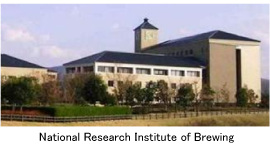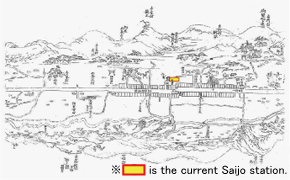

 In the mid Meiji period, the way of brewing Sake which was later called “Ginjo Zukuri” was invented by Sake brewer Senzaburo Miura from Akitsu town by the sea shore and was introduced to the entire country by master brewer Toji from Akitsu town. Saijo, located in the center of Higashihiroshima, was fortunate to have the perfect climate and groundwater for the preparation of Sake in the winter because of its high altitude; therefore, Saijo became a major brewing town and was called “Saijo, the capital of Sake” by the end of the Taisho era and into the Showa era. In the beginning of the Showa era, a vertical rice milling machine, crucial for brewing Ginjo sake (a high-grade sake made from highly milled rice fermented slowly at a low temperature), was invented. Moreover, because of the contrast of temperatures between daytime and nighttime in the summer time and the great quality of the water, high grade rice wine (sake) is being made at the northern plateau part of town.
In the mid Meiji period, the way of brewing Sake which was later called “Ginjo Zukuri” was invented by Sake brewer Senzaburo Miura from Akitsu town by the sea shore and was introduced to the entire country by master brewer Toji from Akitsu town. Saijo, located in the center of Higashihiroshima, was fortunate to have the perfect climate and groundwater for the preparation of Sake in the winter because of its high altitude; therefore, Saijo became a major brewing town and was called “Saijo, the capital of Sake” by the end of the Taisho era and into the Showa era. In the beginning of the Showa era, a vertical rice milling machine, crucial for brewing Ginjo sake (a high-grade sake made from highly milled rice fermented slowly at a low temperature), was invented. Moreover, because of the contrast of temperatures between daytime and nighttime in the summer time and the great quality of the water, high grade rice wine (sake) is being made at the northern plateau part of town.
 As a result, the highest grade, Ginjo Sake, is being made all over Higashihiroshima. In the spring, the National Research Institute of Brewing reviews Ginjo Sake from all over the country, and in the fall, we hold a Sake Festival where we gather Sake from all over the country around the JR Saijo station.
As a result, the highest grade, Ginjo Sake, is being made all over Higashihiroshima. In the spring, the National Research Institute of Brewing reviews Ginjo Sake from all over the country, and in the fall, we hold a Sake Festival where we gather Sake from all over the country around the JR Saijo station.
In the Edo era, there were continuous post stations or “Shukuba” (places where travelers could rest) along the elongated road which extends from east to west in the area where the current Saijo station is. There was a post station called “Yokkaichi” on Saigoku Road (formerly known as Sanyo Street) which became the street that is currently referred to as the “Sakagura Dori (Sake Wine Cellar Street)”. In the center of the posting station, there was a head post station called “Ochaya”, which was under the domain of Hiroshima, and was the largest post station in the domain.

The gate of an imperial residence at Ochaya headquarters remains from when it was called “Yokkaichi” in the post stations time period. (Reconstructed)

In the Edo era, towns were formed along the elongated highway that extends from east to west.
明In the mid Meiji era, the town was renamed from “西条 - Saijo” to “西條 - Saijo”. A railway was built through the center of the town, and a train station was also built. This triggered merchants to reside along the highway and begin brewing Sake at the end of the Meiji era to the beginning of the Taisho era. In the mid Taisho era, three brewing companies, which were rare, were established, and they built brewing warehouses one after another. As a result, the town of “Sakagura Dori”, with its red chimneys and white walls, was born.





